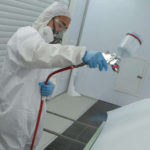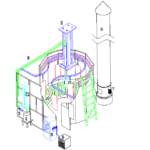Painting is the last but very important stage of wooden door manufacturing process. Due to it’s technical operation, the level of surface finishing can directly tell the factory manufacturing level and competitiveness. The core part of wooden door painting is in three parts: the selection of paint, the design of painting process, and the application of painting equipment.
Selection of Paint
Coatings are mainly available as five types: PU paint (polyurethane paint), PE paint (unsaturated resin paint), NC paint (nitrocellulose paint), UV paint (ultraviolet curing paint), and W paint (water-based paint). In the painting of wooden doors, the above five paints are popularly used. They have different shares in different types of enterprises in different periods.
1- PU Paint
PU is one of the most commonly used paint for door production. It has excellent comprehensive properties, such as: good construction performance, filling, fullness, hardness, ease of sanding, scratch resistance, all have good performance. PU paint is the most popular choice for wooden door painting.
2- PE Paint
PE is mostly used for primer. It is available as transparent primer and colored primer (mainly white primer). PE primer is a kind of paint with high solid content, with high hardness, strong sag resistance and high fullness, but its construction performance is more complicated and brittle. PE finish paint has only high gloss products, no matt finish, so the application of PE finish on wooden door painting is rare.
3- NC Paint
NC paint has a long history which is also a popular choice. Its main applications on wooden doors are: transparent nitrocellulose paint and colored nitrocellulose paint (mainly white and yellow white). Nitrolacquer has excellent construction performance, and the painting operation time is shorter. Transparent nitrocellulose lacquer is often used for “open” and “semi-open” coating effects. The solid color nitrocellulose paint is mostly used for the effect of fully enclosed painting. The most common is to use nitro solid color base and nitro solid color surface for coating operations. Of course, it also has limitations, such as insufficient fullness, poor hardness, poor solvent resistance, and it is not suitable for products with high fullness and high gloss.
4- UV Paint
UV paint is recognized one of the two most eco friendly coatings in the world (the other is water base paint). As a new coating, it has been developed rapidly in recent years in furniture factories such as wooden door factories and wood floor factories. The matching process, equipment and technology are becoming more and more mature. Initially, transparent uv paint was used for flat wooden door products.
With the new technology and equipment technology, solid-color UV paints already developed, and many companies have already used UV coatings to produce solid-color wooden doors. In addition to environmental protection, UV coatings have excellent performance properties, such as good hardness and chemical resistance. Its efficiency is dozens of times than that of general coatings, and the cost of paint used is 1/3-2/3 of general paint. But UV coating also has its limitations. For example, UV coating has a relatively high investment in equipment.
5- W Paint
W paint is short of water-base paint, its eco property is the same as UV paint and it is the most eco friendly paint variety. Water-based paint is a new variety that develops relatively fast in paint varieties. In Europe and the United States, most home decorations are constructed with water-based paint. Applications on wooden furniture and doors are relatively small, but some companies use water-based coatings to meet some specific customer requirements. Water-based coatings have relatively low solid content, thinner paint film, less hardness, poorer water resistance and high cost.
However, with the continuous development of coating technology, these limitations are gradually being resolved. What kind of paint needs to be selected for wooden doors depends on the company’s choice and the different requirements of surface treatment. Only a reasonable selection can achieve the desired effect and save costs of labor and materials.
Spray Coating Technology Design
1- Basic guidelines and process
Follow the customer requirements to wooden door then select suitable paint and confirm the spray coating process and equipment configuration.
2- Wooden door spray coating requirements and standards
- If the customer has no special requirements for environmental protection, “GB-18581” National Standards can be used directly. Or else we have to follow the specific parameters provided by customer.
- Requirements of the surface effect: fully enclosed, semi-open and fully open. Generally it includes: gloss, color, fullness, continuity, hardness, leveling, soft scratch resistance, adhesion, brittleness, etc.
- Requirements of chemical resistance: yellowing resistance, acid and alkali resistance, reflow resistance
3- Selection of coating
The selection of coating is a very important part in the design of coating process. The basis of selection is: finishing requirement, eco requirement, cost control, efficiency and way of operation.
4- Spray painting process
The key stage of wooden door production. The process design is crucial for production efficiency, quality and cost control. Most of the time, we can archieve same finishing by different treatment procedures. But it’s an art to select the most efficient one. It requires knowledge and technology understanding in this area.
5- Selection of painting machine
Once we fixed the paint and process design, the choice of painting machine and configuration will decide the final spraying quality. With the fast rising of labor cost, automatic spray painting and sanding is essential consideration for mass production. Especially for wooden door industry, the sanding efficiency decides the final production capacity which is crucial for company profit.




